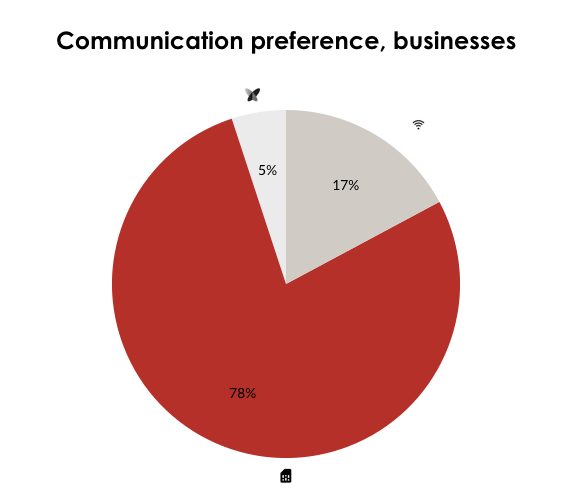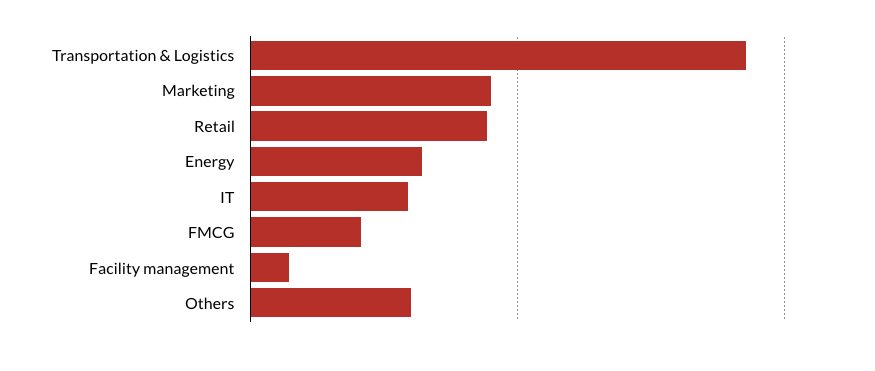Preferences and drivers across industries
I got my hands on the latest statistics of IoT button usage–which I’ll be sharing with you few inches below. I thought it’d be a good opportunity to look at the why’s and how’s; what are businesses’ preferences across different industries when it comes to IoT buttons, what are the biggest drivers, and how various industries use IoT buttons.

Businesses prefer stand-alone connectivity with their IoT buttons
78% of companies chose built-in mobile connectivity in their IoT buttons. Wow.
That’s a lot.
If we take into account the 5% of Sigfox connected buttons, it makes a total of 83% of buttons with stand-alone connectivity compared to mere 17% that are connected to the internet through Wi-Fi.
What makes this 83 against 17 percent comparison significant?
Simply put, it’s a clear signal that companies want to:
- Optimize the total cost of ownership (TCO), where hardware deployment is a major factor
- Gain full control and manageability of their IoT button fleet and;
- Offer ultimate convenience and simplicity for their own customers i.e. the people they give the buttons to.
For clarity’s sake, the most noteworthy benefits of stand-alone connectivity to companies are:
-Mass deployment made easy: Companies can give or deliver bttns to end-users or install locations without having to have a technician install them, as they connect automatically when powered on.
-Remote monitoring and tech support made easy: your personnel can directly see if a bttn is connected and launching actions as expected. With Wi-Fi the bulk of technical support activities relates to troubleshooting heterogenous Wi-Fi networks, routers and passwords at install locations.
-For your customers’ and/or end-users everything is really simple: they just switch the power on and everything works right out-of-the-box. In terms of customer experience it is by far the best possible route.
The total cost of ownership (TCO) of IoT buttons comprise hardware cost, deployment cost and running costs. We can argue that a large part of the TCO comes from deployment costs and associated support costs, and therefore the simple deployment and low level of technical support needs offered by stand-alone connected IoT buttons translate into the lowest possible TCO. In turn, a Wi-Fi solution may become very expensive because of steep support costs or because it sits unused in a drawer instead of contributing to revenue creation.
Had to do a bit of digging in the archives but I found our stats from 2016. There’s been an 11%-unit jump in the built-in mobile connectivity at the cost of Wi-Fi.

Just as a curiosity, here’s how consumers prefer their IoT buttons.

54% chose to have Wi-Fi connectivity. As to why that is, your guess is as good as mine.
Naturally, if you have an existing Wi-Fi network in your home, you can attach lots of different tools and gadgets to it without additional costs. Makes sense.
Preferences between built-in mobile vs Wi-Fi aside, Sigfox connectivity is now almost on par on consumers’ side and businesses side.

Looking at the 2016 stats, adoption of Sigfox connectivity has doubled on consumers’ side. Can that be attributed to the simple and affordable connectivity? Perhaps.
Top actions businesses use with their IoT buttons
Looking at the graph it’s immediately clear what businesses want to do–and are doing–the most: they integrate IoT buttons to their existing business systems and platforms.
What those systems and platforms are I can’t disclose, but I can show the breakdown of our customer segments. This will give you an idea of what is going on in the IoT button landscape.
With bttn’s REST API (and bttn for Commerce API that allows secure linking of bttns with your online ordering system to provide your customers a one-press ordering experience) integrations to custom systems as well as 3rd party platforms work like a charm.
Tip: If you haven’t checked bttn’s supported 3rd party platforms for awhile, you can find them here)
Email is kind of interesting and noteworthy. No matter what your industry is, you can build simple on-demand services with email action: your customer presses a button and your staff gets an email giving instructions and contact info.
Zapier made the top 5 list but it’s trailed by similar services like Microsoft Flow and IFTTT. All enabling automations, automated workflows and the likes. Oh, and there’s bunch of on-demand services built with these, too.
As a comparison, here are the top actions from consumers’ side.
Top industries that are driving IoT button adoption
What’s the best way to hail a cab? The simplest way – pressing a bttn – of course.

If you’re interested in the business case of such on-demand taxi hailing you may wish to check the “Cheat sheet for the taxi industry: how to hoard orders with on-demand ordering” post.
Similar logic and use apply to logistics business although there are different unit economics in play.
Marketing encompasses lots of various uses and industries. All in all, these are cases that originate from ad agencies and digital agencies that develop campaigns, service design and promotional tactics. Looking at common denominators, customer engagement sure is at the top.

If you wish to influence these stats, the absolutely, positively best way is to begin to develop your own services using our IoT buttons. Fastest way to start is by requesting a bttn demo.
Make magic happen.
Download your free copy of IoT buttons in numbers 2017.





